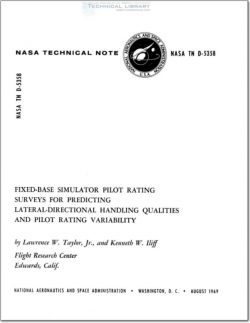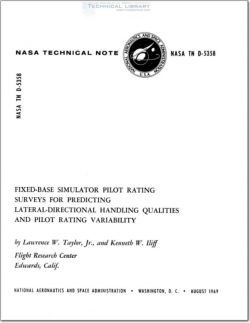NASA-TN-D-5358

- Version
- 201 Downloads
- 2.59 MB File Size
- 1 File Count
- June 15, 2016 Create Date
- June 15, 2016 Last Updated
Fixed-Base Simulator Pilot Rating Surveys for Predicting Lateral-Directional Handling Qualities and Pilot Rating Variability

The handling qualities of aircraft have been the subject of many investigations.
Analytical methods and fixed—base and in—flight simulators have been used to investigate
the influence of a variety of parameters on handling qualities. References 1 to 15
represent a partial bibliography of lateral—directional studies. Criteria based on these
studies have been guides in airplane design and have provided a general understanding
of the effects of many parameters. Increased airplane performance, larger operating
envelopes, and new design considerations necessitate a continued refinement and im—
provement in handling—qualities knowledge.
Methods of estimating and assessing handling qualities are available as, for instance,
the use of closed-loop pilot—airplane systems analysis (for example, refs. 11 to 13),
ground—based flight simulators (for example, refs. 5, 14, and 15), and in—flight
simulators (for example, refs. 1 to 4 and 10). The more sophisticated and reliable
methods, however, require considerable time and effort; hence, a method is needed that
can be easily applied. It was reasoned that an assessment of the handling qualities of
all combinations of several airplane parameters over wide ranges of operating conditions
would provide handling—qualities data on which predictions could be based. Such a survey
was undertaken at the NASA Flight Research Center, utilizing a fixed—base simulator.
The results of the survey——lateral—directional handling qualities as defined by pilot
ratings ——are presented in this paper. Pilot ratings were selected as the most significant
criteria, for it is the pilot who must finally judge the acceptability of the airplane. The
first part of the investigation was a general survey in which pilot ratings were obtained
by an engineer for numerous combinations of the five most pertinent handling—qualities
parameters.
Inasmuch as many factors influence pilot ratings of airplane characteristics, the
second part of the investigation was a survey that utilized many pilots in order to study
pilot variability for a general flight mission. In addition, the effect of mission on pilot
rating was investigated by considering five other missions. These results are presented
herein in order to increase the applicability of the results from the general survey.
The results of this investigation are intended to provide a rapid means of predicting
airplane handling qualities in which several parameters are considered simultaneously.
It is not intended, however, to replace detailed simulation investigations of the handling
qualities of an airplane, such as during final design and flight testing.
| File | Action |
|---|---|
| NASA-TN-D-5358 Fixed-Base Simulator Pilot Rating Surveys for Predicting Lateral-Directional Handling Qualities and Pilot Rating Variability.pdf | Download |

Comment On This Post